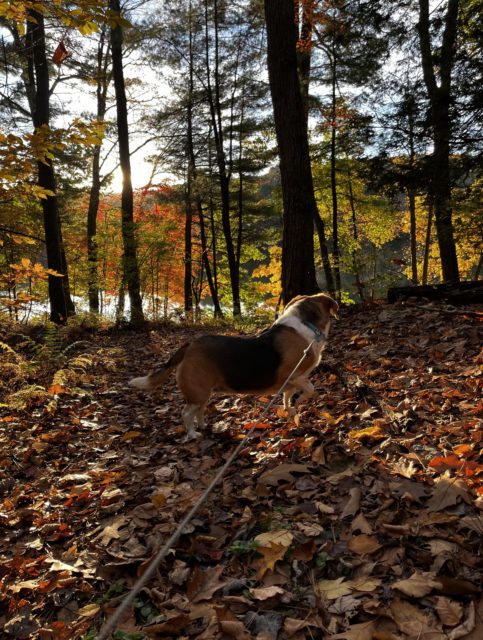Krystal Daniele SCA New Hampshire Corps- Discover the Power of Parks Interpretive Ranger
Adventuring with our pets is an exciting experience for us and them. There are so many new sights, sounds and smells! As a pet owner myself, I often think about how I can keep my dog safe on the trails. Pets can be easily overwhelmed by new people and other animals. To ease the anxiety of recreating, I find preparing ahead of time to be beneficial. Having the appropriate gear and plan for your dog provides security to you and others.
Prepare
Preparation is key when going on a hike, whether it be alone or with your pet. Some of the things that I prepare for commonly include: weather, other animals, injury, hydration, comfort, etc. If your animal has any special needs such as medicine or health concerns, please keep those in mind as well. Depending on your pets age, ability, and activity level, it is best to find a trail that is well suited to them. Trail difficulty should always be considered before taking your pet on a hike. When I prepare to take my dog outside to recreate, there are a few key essential items that I like to bring. In a backpack, I typically to pack extra water, a bowl, an extra collar and leash, waste bags, treats, and first aid items. If your dog has more or less needs, you can pack more accordingly to them. To ensure my pets safety, I fit him in clothes that are specific to our activities. During the winter months, I bring along a winter or fleece jacket. I always fit my dog with a life jacket when participating in watersports. I also bring dog shoes to prevent paw injuries from heat or foreign objects. I bring these items to ensure safety from possible hazards. There are more ways to protect our companions.


Defense
So, how do we protect our pets from the invisible threats? Pests such as ticks, fleas, or heart worm can be a major concern when adventuring. However, there are precautions that pet owners can take to keep their companions healthy. I treat my dog with a 2 in 1 medication. The medicine protects against against fleas and ticks. Living in New England, Lyme’s disease is always a top concern for us. When it comes to heart worms, prevention is key. Dogs contract heart worms from infected mosquitoes. It is best to prevent heartworm than to treat it. By the time your dog may start to show symptoms, it could be too late.

Best Practice
When taking our pets out to recreate, there are laws and there are best practices. A best practice is something that might not be the law, but it is the most considerate or ethical way of doing something. 2 topic always come to mind when I think of best practice while hiking with out pets. The first is leash safety. New Hampshire State Parks do require people to leash their animals. This is often not what is seen on the trails. Leash requirements are put in place to protect your pet, others pets, wildlife, and more. Many dogs, like mine, are dog selective. This means that other dogs can make him nervous or defensive. Many pet owners are made nervous by loose dogs. Another reason to leash your pet is for their safety. It can help prevent injury or illness. Dogs will often times eat or drink things from the trail that are not safe for their consumption. Standing water or puddles can hold bacteria or chemicals that can make our pups sick. The same goes for berries or mushrooms, which can be deadly to them. The second best practice that comes to mind is cleaning up after our pets. Animal waste can carry dieses that are easily transferred to other animals. Make sure to carry waste bags with you, and if you forget, ask a fellow pet owner! I’m sure they would be happy to help. Be sure to carry the waste bags back out with you. forgetting them on the trail is commonly seen.

Where To Hike
New Hampshire has numerous parks and trails that are pet friendly. There are also some places where we cannot being our pets to hike. Some of these places include Mount Monadnock, North Hampton State Beach, and Odiorne Point State Park. Pets are not permitted at these parks year round. Some Parks in New Hampshire will allow dogs seasonally or all year. If you are looking for great hikes to take with you pup this summer, there are plenty! Arethusa falls is a very popular hike among pet owns. The mild trail along with the water fall is an attraction. Other popular trails locations include: Franconia Notch, Miller State Park, Gap Mountain, and more. Check out the New Hampshire State Parks website for a complete listing of parks and pet restrictions.
Please remember that all pets are different. You should do what is best for you and your pup! Enjoy your time at New Hampshire’s beautiful parks!

